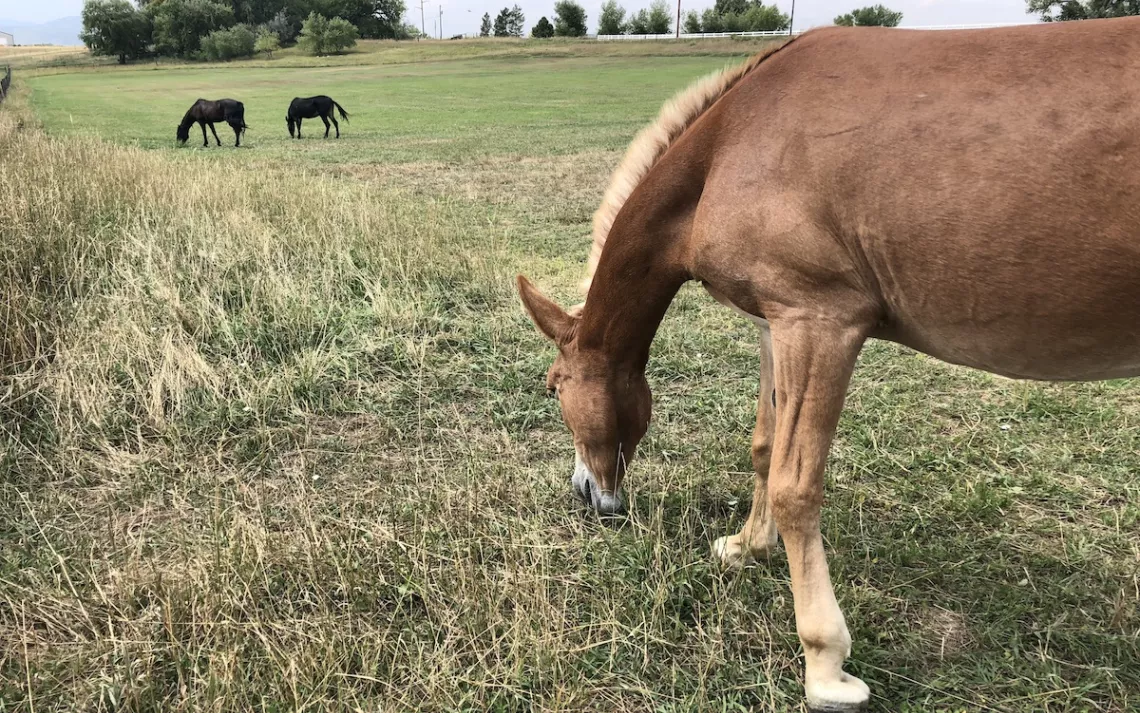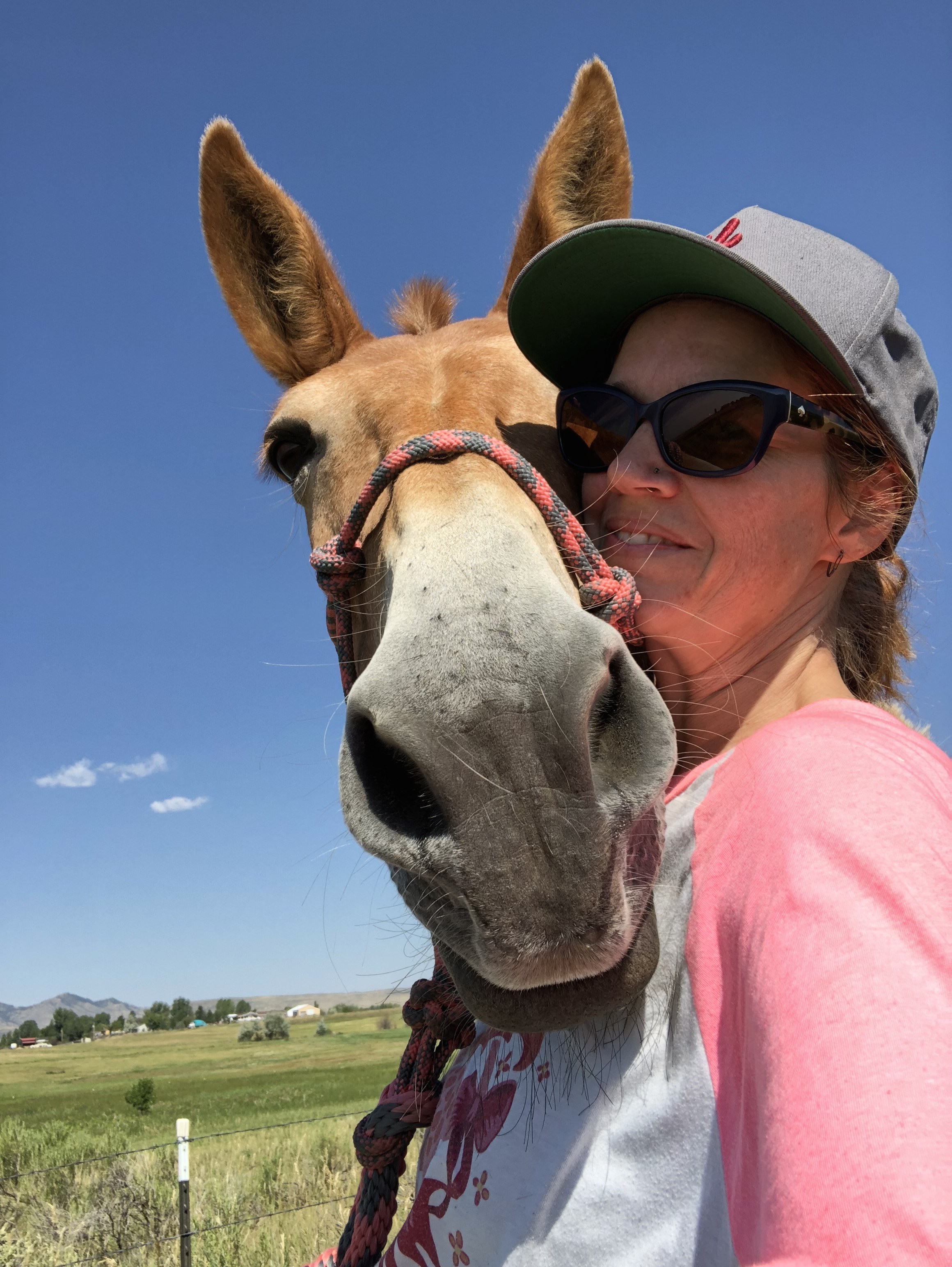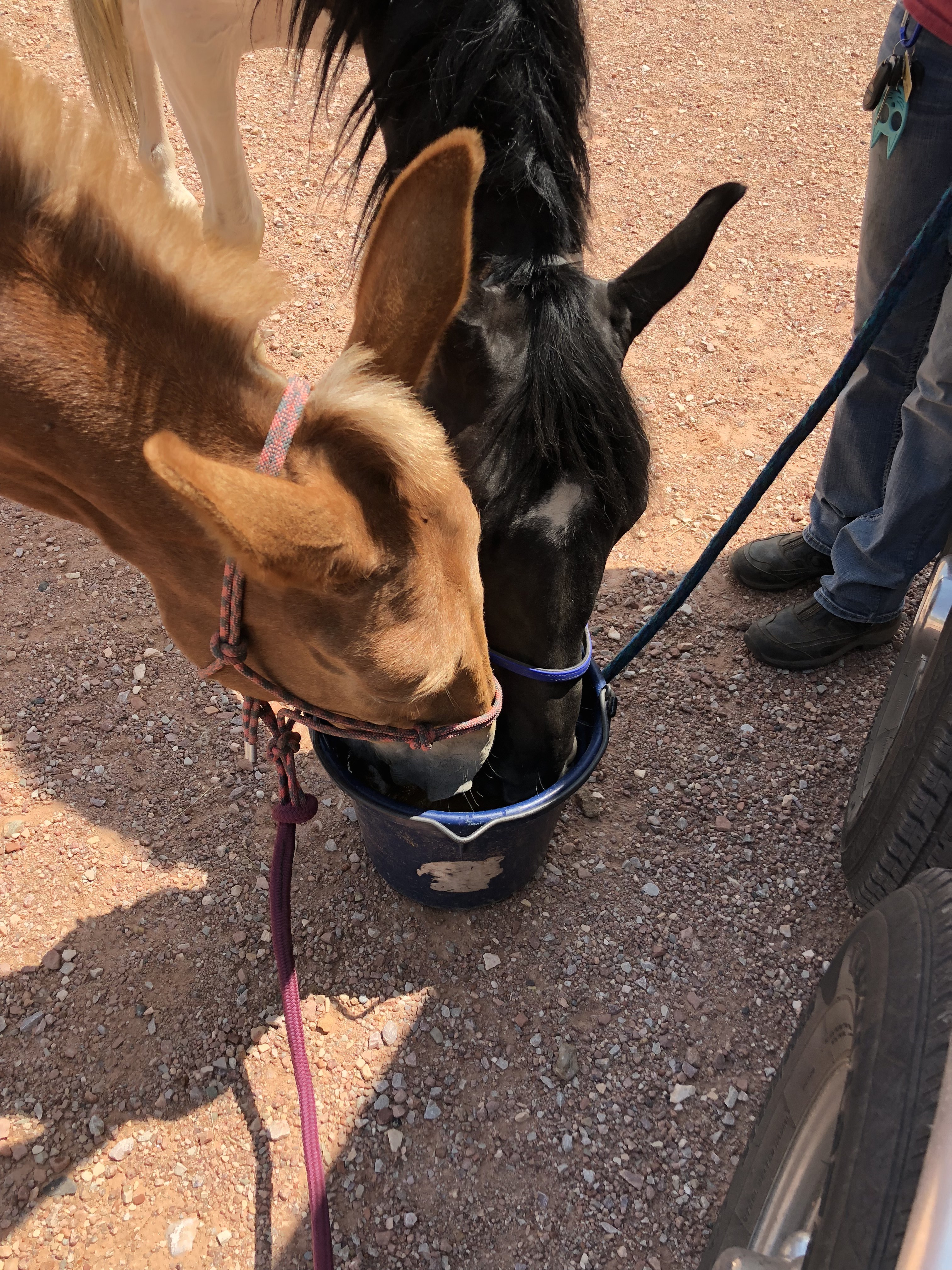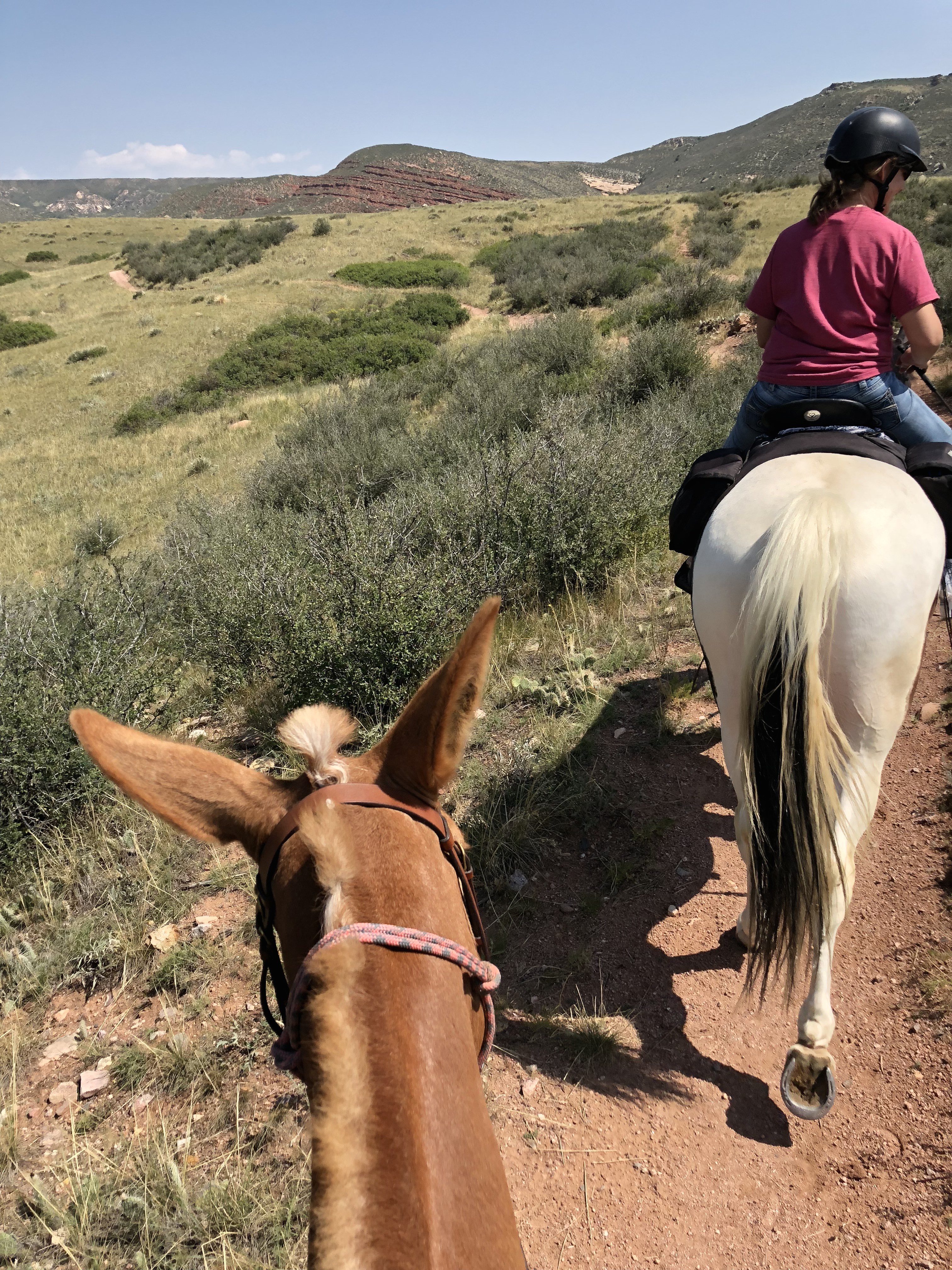A Woman and Her Mule in the Backcountry
The practice, history, and ethics of bringing stock into the wilderness

Photos courtesy of Stacey McKenna
As we rounded the hillside, my mule Daisy cocked her head, swiveling her gloriously long ears toward a trilling sound emanating from the rubber rabbitbrush. On my own, I might easily have missed the strange noise, but not my tuned-in friend. On alert, she moved cautiously along the packed, red-earth trail, the rowdy bush animal to our right and a steep 10-foot drop to our left. Like other prey animals, horses and mules have a sensitivity to their surrounds that we predators lack—they watch for changes in familiar landscapes, listen hard when trees or bluffs hinder their views, and sniff the air for hints of what’s to come.
 When I decided to get a mule—with the ultimate goal of (ad)venturing together into the backcountry—I was simply trying to reconcile my lifelong obsession with equines with my more recently cultivated affection for the wild places of the western United States. The idea of packing on foot or muleback through deserts and mountains seemed like the ultimate way to test my own mettle, bond with an animal, and shrug off the impostor syndrome I sometimes experience as a fairly recent transplant to Colorado and its great outdoors. But with that decision, I stepped onto a communal path as entwined with the history of America’s wilderness as it is with my own journey (or ego).
When I decided to get a mule—with the ultimate goal of (ad)venturing together into the backcountry—I was simply trying to reconcile my lifelong obsession with equines with my more recently cultivated affection for the wild places of the western United States. The idea of packing on foot or muleback through deserts and mountains seemed like the ultimate way to test my own mettle, bond with an animal, and shrug off the impostor syndrome I sometimes experience as a fairly recent transplant to Colorado and its great outdoors. But with that decision, I stepped onto a communal path as entwined with the history of America’s wilderness as it is with my own journey (or ego).
Equines, after all, have for millennia been opening up worlds for humans. The literal harnessing of horse power made the Mongol Empire possible and remains central to the cultures of the Shoshone, Lakota, and other Native American societies. Mules—half donkey, half horse—came into favor in North America when their “hybrid superiority” proved essential to European expansion into the western part of the continent. Smart, tough, and athletic, they hauled wagonloads of supplies between mines, ports, and cities and, along with horses, eventually became key to accessing the backcountry.
For me, for now, I’m just trying to get it right. After all, I’m doing this because I like the way the world looks between two ears. I like the perspective shift in trying to experience a place the way my horse or mule does. But I’ve had plenty of friends lament manure on trails, sneer at overgrazed campsites, and pose aloud the question of whether stock animals should be on trails at all. To this day, however, wilderness in the United States is largely maintained, and partially defined, by the presence of equines.
When Howard Zahniser, one of the authors of 1964’s Wilderness Act, developed knee problems, he turned to horses in order to keep visiting his beloved backcountry, and ultimately wrote the policy with equine access in mind. “When we talk about looking back how wilderness was designated, the Wilderness Act says it should be an area big enough to able to absorb a two-week pack trip,” says Ari Hertz, a horsepacking instructor with the National Outdoor Leadership School (NOLS) in Lander, Wyoming. “This is what they were thinking about when they were preserving these areas.”
Even John Muir—the Sierra Club’s founding naturalist, who sometimes derided the potential noise and disruption caused by the use of equines or other pack animals—often found himself exploring the Sierra Nevada with four-legged, long-eared, sure-footed companions. In fact, from 1868 to 1873 he frequently traveled on muleback; 30 years later, when he brought along Theodore Roosevelt to experience the wonders of Yosemite, it was with pack mules in tow.
Today, riders continue to recreate in the wilderness, and teams of mules and horses still lug tools and supplies into the backcountry for trail maintenance and firefighting crews. In fact, the Back Country Horsemen of America (BCHA), a 12,000-person network with volunteers in 31 states, is one of the nation’s most active organizations advocating for our public lands.
“Our goal, in alignment with our mission, is to keep trails open for recreational pack stock and to perpetuate the common sense use of horses and mules in the wilderness and backcountry,” says Randy Rasmussen, the BCHA’s Director of Public Lands & Recreation. “To perpetuate your use, you need to make sure those wild lands are in good shape, are protected, and have policies that encourage public access to our public lands. So while we’re not a conservation group per se, there are many things we do to protect the backcountry and the wilderness.”
Most recently, the BCHA has been working with the American Hiking Society, the Wilderness Society, the International Mountain Bike Association, and others to dissuade Congress from changing the Wilderness Act to allow for motorized transport.
 But, more often, BCHA’s efforts can be found in the backcountry itself. Beyond their old-school preferred modes of travel, volunteers build and maintain trails using primitive tools such as the cross-cut saw. “When we go backpacking, we just assume the agency is keeping trails open,” says Rasmussen. “But with budget cuts, our volunteers are picking up the slack.… The public often doesn’t realize that their ability to access trails in the wilderness is increasingly enhanced by volunteers. One of those is the Back Country Horsemen.”
But, more often, BCHA’s efforts can be found in the backcountry itself. Beyond their old-school preferred modes of travel, volunteers build and maintain trails using primitive tools such as the cross-cut saw. “When we go backpacking, we just assume the agency is keeping trails open,” says Rasmussen. “But with budget cuts, our volunteers are picking up the slack.… The public often doesn’t realize that their ability to access trails in the wilderness is increasingly enhanced by volunteers. One of those is the Back Country Horsemen.”
Unfortunately, horses, mules, and other pack animals, especially in large groups, can potentially become the disruptive force that Muir cautioned against. Ignorant or unconcerned outfitters might let their animals overgraze areas they return to repeatedly. A 1,000-pound horse produces about 50 pounds of raw waste—feces and urine—per day, which, unaddressed, can make a mess of a campsite or spread invasive seeds.
But it is possible to embrace leave-no-trace ethics while horsepacking. Strategies like sticking to trails, feeding animals weed-free hay, scattering manure (to help it decompose more quickly), and rotating grazing areas during longer stays all reduce stock animals’ impact on the land. Ultimately, just as it pertains to humans, the stock version of LNT is about being able to make circumstance-driven decisions that are respectful of the land and of others, human and nonhuman, who might want to use it after you.
To help train potential riders and packers on making these decisions, the BCHA offers the nation’s first certified Leave No Trace Stock Master Educator courses. NOLS also runs horsepacking courses that give students tools for being environmentally responsible. Both courses focus on principles more than specifics. For example, rather than telling students they should always or never pack in hay, NOLS horsepacking instructors might discuss the equine digestive tract, the fragility of riparian zones, and those aspects of a camp that’ll support both human and horse herds.
After Daisy and I wrapped up that first trail ride together, I removed her tack and gave her water and a snack. I rubbed away sweat marks and checked her feet for stones. I stroked her neck and scratched her giant ears. And I stood, quietly, looking at the cliffs and the sage and cacti, and listening for strange creatures that I’d heard but never noticed before.
 Most of us humans, whether on horseback or foot, head into the wilderness for the very reason Zahniser wanted to preserve it—so we could “stand without our mechanisms that make us immediate masters over our environment.” And while my beloved mule might sometimes carry my load for me, there’s nothing quite like partnering with and caring for an animal to remind us that we’re not actually master over anything.
Most of us humans, whether on horseback or foot, head into the wilderness for the very reason Zahniser wanted to preserve it—so we could “stand without our mechanisms that make us immediate masters over our environment.” And while my beloved mule might sometimes carry my load for me, there’s nothing quite like partnering with and caring for an animal to remind us that we’re not actually master over anything.
 The Magazine of The Sierra Club
The Magazine of The Sierra Club



